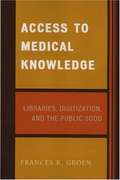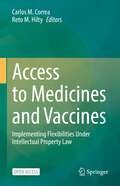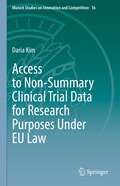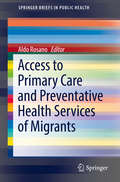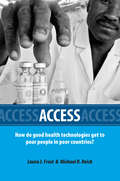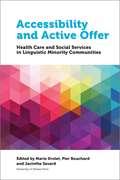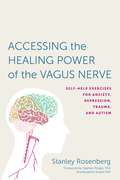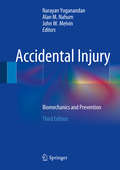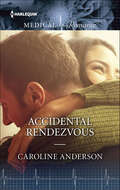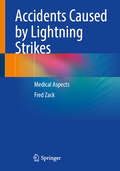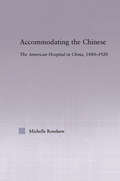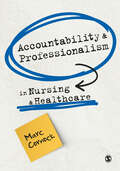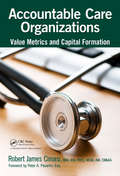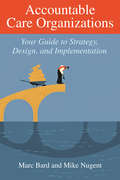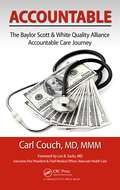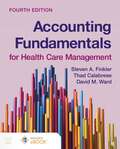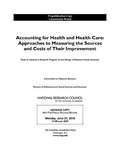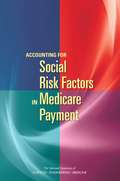- Table View
- List View
Access to Medical Knowledge: Libraries, Digitization, and the Public Good
by Frances K. GroenGroen examines medical librarianship, tracing its history, and considering changes in the field caused by developments in information technology and telecommunications.<P> She attempts to understand why librarians make certain choices and develop certain services. She draws on her own experiences as a medical librarian and in associations and defines three core values of medical librarians: providing access to the medical literature, empowering and educating library users, and preserving the wisdom of the past. Discussion revolves around access to clinical information and consumer health information in the internet age, challenges to providing access, alternative methods, and communication. The book is meant for medical librarians, professors, and other library and information professionals.<P> Groen has been affiliated with Falk Library of the Health Professions, U. of Pittsburgh, and the medical library at McGill U. in Canada. Annotation ©2007 Book News, Inc., Portland, OR (booknews.com)
Access to Medicine Versus Test Data Exclusivity: Safeguarding Flexibilities Under International Law (Munich Studies on Innovation and Competition #4)
by Owais H. ShaikhThis book explores the concept of test data exclusivity protection for pharmaceuticals. Focusing on Art 39(3) of the WTO Agreement on Trade-Related Aspects of Intellectual Property Rights (TRIPS Agreement) and relevant provisions in selected free trade agreements (FTA) and national laws, it combines normative, historical, comparative and economic analysis of test data exclusivity protection. At the heart of this book is the novel and original Index of Data Exclusivity and Access (IDEAS), which analyzes the effectiveness of test data exclusivity provisions in FTAs and national laws both on the strength of exclusivity as well as on access to medicine. IDEAS provides a framework for the assessment of current test data exclusivity protection standards on the basis of their proximity to Article 39(3) of the TRIPS Agreement, the scope of exclusivity and the flexibilities in FTAs, and subsequently in national laws. This book aims to broaden national and international policy makers' grasp of the various nuances of test data exclusivity protection. Furthermore, it provides practical recommendations with regard to designing an appropriate legal system with a strong focus on promoting access to medicine for all.
Access to Medicines and Vaccines: Implementing Flexibilities Under Intellectual Property Law
by Reto M. Hilty Carlos M. CorreaThis open access book is the outcome of a Global Forum on Innovation, Intellectual Property and Access to Medicines held in December 2019 at the Max Plank Instititute in Munich, organised by the South Centre and the Max Plank Institute. The academics and experts from international organisations participating have contributed chapters to this book. The book is for policy makers (in Ministries of Health, Ministries of Trade, Ministries of Foreign Affairs, patent offices), but also relevant for academics (law, trade, public health), on the flexibilities available in the Agreement on Trade Related Aspects of Intellectual Property Rights (TRIPS) of the World Trade Organization to promote access to medicines.
Access to Medicines as a Human Right
by Jillian Clare Kohler Lisa FormanAccording to the World Health Organization, one-third of the global population lacks access to essential medicines. Should pharmaceutical companies be ethically or legally responsible for providing affordable medicines for these people, even though they live outside of profitable markets? Can the private sector be held accountable for protecting human beings' right to health?This thought-provoking interdisciplinary collection grapples with corporate responsibility for the provision of medicines in low- and middle-income countries. The book begins with an examination of human rights, norms, and ethics in relation to the private sector, moving to consider the tensions between pharmaceutical companies' social and business duties. Broad examinations of global conditions are complemented by case studies illustrating different approaches for addressing corporate conduct. Access to Medicines as a Human Right identifies innovative solutions applicable in both global and domestic forums, making it a valuable resource for the vast field of scholars, legal practitioners, and policymakers who must confront this challenging issue.
Access to Non-Summary Clinical Trial Data for Research Purposes Under EU Law (Munich Studies on Innovation and Competition #16)
by Daria KimThis book draws a unique perspective on the regulation of access to clinical trial data as a case on research and knowledge externalities. Notwithstanding numerous potential benefits for medical research and public health, many jurisdictions have struggled to ensure access to clinical trial data, even at the level of the trial results. Pro-access policy initiatives have been strongly opposed by research-based drug companies arguing that mandatory data disclosure impedes their innovation incentives. Conventionally, access to test data has been approached from the perspective of transparency and research ethics. The book offers a complementary view and considers access to individual patient-level trial data for exploratory analysis as a matter of research and innovation policy. Such approach appears to be especially relevant in the data-driven economy where digital data constitutes a valuable economic resource. The study seeks to define how the rules of access to clinical trial data should be designed to reconcile the policy objectives of leveraging the research potential of data through secondary analysis, on the one hand, and protecting economic incentives of research-based drug companies, on the other hand. Overall, it is argued that the mainstream innovation-based justification for exclusive control over the outcomes of research and development can hardly rationalise trial sponsors’ control over primary data from trials. Instead, access to such data and its robust analysis should be prioritised.
Access to Primary Care and Preventative Health Services of Migrants (SpringerBriefs in Public Health)
by Aldo RosanoThis salient volume surveys the state of access to primary care and preventive health services by migrants, refugees, and asylum seekers across Europe. Experts in public health and allied fields identify obstacles to healthcare interventions for migrants, including costs, legal status, health-related behaviors and beliefs, and cultural and language barriers. The book includes the latest data concerning access to specific preventive services (e.g., vaccinations, colorectal screenings), specific issues of women and sexual minorities, and the potential for health promotion in prevention. Best practices for improving access are outlined as a basis for public health and policy directives toward reducing health disparities between migrant and native populations.<P><P> Among the topics covered: <P> Access to medical examination for prevention among migrants; Access and barriers to infant vaccinations, female cancer screening and colorectal screening among migrant populations; Provision and policy gap between the primary and preventive care required by and the care provided to LGBTQ+ migrants, refugees, and asylum seekers; Health related lifestyles and intermediate health conditions of migrants; Quality of primary healthcare and preventive health services provided to migrants; Adaptations of primary health care for migrants; Access to primary health care and policies on migration and health at a time of economic crisis.<P> Dedicated to bridging research and policy gaps in this vital area, Primary Care Access and Preventive Health Services of Migrants is intended for an international audience of academics, researchers, policymakers, and practitioners in public health and related disciplines.
Access: How Do Good Health Technologies Get to Poor People in Poor Countries?
by Michael Reich Laura J. FrostMany people in developing countries lack access to health technologies, even basic ones. Why do these problems in access persist? What can be done to improve access to good health technologies, especially for poor people in poor countries?This book answers those questions by developing a comprehensive analytical framework for access and examining six case studies to explain why some health technologies achieved more access than others. The technologies include praziquantel (for the treatment of schistosomiasis), hepatitis B vaccine, malaria rapid diagnostic tests, vaccine vial monitors for temperature exposure, the Norplant implant contraceptive, and female condoms. Based on research studies commissioned by the Bill & Melinda Gates Foundation to better understand the development, adoption, and uptake of health technologies in poor countries, the book concludes with specific lessons on strategies to improve access. These lessons will be of keen interest to students of health and development, public health professionals, and health technology developers--all who seek to improve access to health technologies in poor countries. This edition now includes a new preface by the authors.
Accessibility and Active Offer: Health Care and Social Services in Linguistic Minority Communities (Health and Society)
by Marie Drolet, Pier Bouchard and Jacinthe SavardIt is imperative that we train leaders who are able to intervene efficiently with service users and to support a better organization of the workplace. It is especially important to look at the many issues related to postsecondary training and human resources, such as recruiting and keeping these leading professionals. Accessibility and Active Offer thus combines theory and empirical data to help future professionals understand the workplace issues of accessibility and active offer of minority-language services. This English-language adaptation of Accessibilité et offre active features an additional chapter by Richard Bourhis on issues specific to Anglophone communities in Québec. This multidisciplinary collective work is the first to unite researchers in health, social work, sociology, political science, public administration, law and education, in order to gain more thorough knowledge of linguistic issues in health and social services, as well as of active offer of French-language services. Published in English.
Accessibility, Inclusivity and Diversity in Education and Beyond (Biomedical Visualization #8)
by Rachael DoorThis book provides a unique opportunity to explore the current and future state of accessibility, inclusivity, and diversity across higher education and beyond. Although these chapters primarily focus on the issues and resulting adaptations seen in biomedicine, the results and observations are applicable throughout education and the workplace. Section 1 focuses on what it means to create accessible environments for both education and employment. Here the pitfalls of mandatory attendance across education will be addressed and ideas for building belonging amongst students shared. In addition, ways to use play-based learning to support student revision and to make psychology accessible to medical students will be discussed. Section 2 explores inclusive practices in anatomy education and research, with a toolkit for both early-career and established academics. The pedagogy, psychology, and culture of asking and answering questions in education will also be explored to support educators aiming to create inclusive learning environments. Section 3 focuses on ways in which diversity can be embraced in the educational, medical, and public sectors. Chapters include the use of human remains as teaching aids to promote the concept of the body as a spectrum, and the use of television media to create immersive learning environments. This book is an essential guide to creating accessible, inclusive, and diverse learning environments for both the early career and experienced academic.
Accessing the Healing Power of the Vagus Nerve: Self-Help Exercises for Anxiety, Depression, Trauma, and Autism
by Benjamin Shield Stephen W. Porges Stanley RosenberyThis practical guide to understanding the cranial nerves as the key to our psychological and physical well-being builds on Stephen Porges’s Polyvagal Theory—one of the most important recent developments in human neurobiology. Drawing on more than thirty years of experience as a craniosacral therapist and Rolfer, Stanley Rosenberg explores the crucial role that the vagus nerve plays in determining our psychological and emotional states and explains that a myriad of common psychological and physical symptoms—from anxiety and depression to migraines and back pain—indicates a lack of proper functioning in the vagus nerve. Through a series of easy self-help exercises, the book illustrates the simple ways we can regulate the vagus nerve in order to initiate deep relaxation, improve sleep, and recover from injury and trauma. Additionally, by exploring the link between a well-regulated vagus nerve and social functioning, Rosenberg’s findings and methods offer new hope that by improving social behavior it is possible to alleviate some of the symptoms at the core of many cases of autism spectrum disorders. Useful for psychotherapists, doctors, bodyworkers, and caregivers, as well as anyone who experiences the symptoms of chronic stress and depression, this book shows how we can optimize autonomic functioning in ourselves and others, and bring the body into the state of safety that activates its innate capacity to heal.
Accidental Injury: Biomechanics and Prevention
by Narayan Yoganandan Alan M. Nahum John W. MelvinThis book provides a state-of-the-art look at the applied biomechanics of accidental injury and prevention. The editors, Drs. Narayan Yoganandan, Alan M. Nahum and John W. Melvin are recognized international leaders and researchers in injury biomechanics, prevention and trauma medicine. They have assembled renowned researchers as authors for 29 chapters to cover individual aspects of human injury assessment and prevention. This third edition is thoroughly revised and expanded with new chapters in different fields. Topics covered address automotive, aviation, military and other environments. Field data collection; injury coding/scaling; injury epidemiology; mechanisms of injury; human tolerance to injury; simulations using experimental, complex computational models (finite element modeling) and statistical processes; anthropomorphic test device design, development and validation for crashworthiness applications in topics cited above; and current regulations are covered. Risk functions and injury criteria for various body regions are included. Adult and pediatric populations are addressed. The exhaustive list of references in many areas along with the latest developments is valuable to all those involved or intend to pursue this important topic on human injury biomechanics and prevention. The expanded edition will interest a variety of scholars and professionals including physicians, biomedical researchers in many disciplines, basic scientists, attorneys and jurists involved in accidental injury cases and governmental bodies. It is hoped that this book will foster multidisciplinary collaborations by medical and engineering researchers and academicians and practicing physicians for injury assessment and prevention and stimulate more applied research, education and training in the field of accidental-injury causation and prevention.
Accidental Rendezvous
by Caroline AndersonAn emotional emergencyIn the seven years since their breakup, Sally has had to come to terms with some strong emotions. When Nick Baker suddenly turns up at the Audley emergency department, Sally cannot face having him in her personal life again.But Nick has been searching for her, and now that he’s found her he’s not going to let her go. He expects Sally to be angry with him; he discovers that she’s also angry with herself. Because all those years ago they had a baby daughter and Nick never had the chance to be her dad.
Accidentally Dating His Boss
by Kristine LynnWhat will the plastic surgeon do when he discovers the anonymous online friend he&’s been falling for…is his boss? Find out in Kristine Lynn&’s captivating new book for Harlequin Medical Romance. ONLINE MATCH, REAL-LIFE RIVALS! Plastic surgeon to the stars, Dr. Owen, is not happy with his new boss&’s ideas. And it doesn&’t help that Dr. Kris is infuriatingly stunning! Thankfully, Owen has @ladydoc to vent to. He doesn&’t have space in his life for dating, but the anonymity of their virtual relationship protects them both. Yet, when Owen discovers the unthinkable—that Kris is his cyber crush!—will he be brave enough to bring their accidental connection offline?From Harlequin Medical: Life and love in the world of modern medicine.
Accidents Caused by Lightning Strikes: Medical Aspects
by Fred ZackThe book presents relevant medical aspects of accidents caused by lightning strikes in a practical manner and is supported by case examples: from the fundamentals of energy transfer to emergency medical first aid, the treatment of sequelae, and the medical examination of the deceased. It is aimed at physicians of all specialties who are involved in the acute care or follow-up of individuals after lightning strike accidents, such as those from emergency medicine, legal medicine, intensive care, and general medicine.
Accommodating the Chinese: The American Hospital in China, 1880-1920 (East Asia: History, Politics, Sociology and Culture)
by Michelle Campbell RenshawThis in-depth comparative study demonstrates that the hospital established in China - its planning and architecture, financing, and all aspects of day-to-day operation - differed from its counterpart at home. These differences were never due to a single, or even dominant cause. They were a result of a complex process involving accommodation, appreciation, negotiation, opportunism and pragmatism.
Accountability and Professionalism in Nursing and Healthcare
by Marc CornockThis is the ideal textbook for students and practitioners of all levels. Using over 130 frequently asked questions and corresponding answers, the style makes you feel as though you′re talking to an expert. The layout is easy to use and accessible, with all answers written in line with Nursing and Healthcare regulations. Questions include: If I have concerns about a colleague what should I do? Can a patient demand a specific treatment? When is it possible to treat a patient without their consent? What happens at a Coroner’s Inquest? Find answers to these and many more questions to unravel the complexities of accountability and professionalism in nursing and healthcare.
Accountability and Professionalism in Nursing and Healthcare
by Marc CornockThis is the ideal textbook for students and practitioners of all levels. Using over 130 frequently asked questions and corresponding answers, the style makes you feel as though you′re talking to an expert. The layout is easy to use and accessible, with all answers written in line with Nursing and Healthcare regulations. Questions include: If I have concerns about a colleague what should I do? Can a patient demand a specific treatment? When is it possible to treat a patient without their consent? What happens at a Coroner’s Inquest? Find answers to these and many more questions to unravel the complexities of accountability and professionalism in nursing and healthcare.
Accountability in Social Services: The Culture of the Paper Program (Haworth Health and Social Policy Series)
by Jill Florence LackeyAccountability in Social Services examines how - and why - social and human services programs can function even though they are monitored by written communication instead of face-to-face interaction. Author Jill Florence Lackey draws on her experience as a consultant for more than 50 social programs and as director of two nonprofit organizations to demonstrate the strong need for accountability mechanisms and an ethics-based leadership when running social service programs. This unique book walks you through the process of how “paper programs” emerge and operate, the monitoring mechanisms that are - and aren’t - in place during program operations, and recommendations to increase accountability in the social service delivery system.The book examines programs focusing on: youth aftercare adolescent health drug prevention rural community development crime prevention violence intervention services to the homeless and more.Accountability in Social Services concludes with recommendations for organized action by consumer groups to increase responsibility in the social service delivery system. This book is invaluable as a resource for students, teachers, and practitioners working in social work and welfare, evaluation, organizational leadership, public policy, applied anthropology, and consumer science, including local organizations such as PIRGs (Public Interest Research Groups).
Accountable Care Organizations: Value Metrics and Capital Formation
by Robert James CimasiAn accountable care organization (ACO) is a healthcare organization characterized by a payment and care delivery model that seeks to tie provider reimbursements to quality metrics and reductions in the total cost of care for an assigned group of patients. Accountable Care Organizations: Value Metrics and Capital Formation explores the historical ba
Accountable Care Organizations: Your Guide to Strategy, Design, and Implementation (ACHE Management)
by Marc BardIs the ACO strategy right for your organization? Accountable Care Organizations will help you understand the ACO framework and assess your readiness to embark on an ACO strategy. This book provides the structural blueprints, management skills, and cultural tools necessary to implement a successful ACO. Practical advice is bolstered with real world examples of leading healthcare providers that are pioneers in the rapidly changing world of accountable care. This guidebook is designed to facilitate critical conversations and decisions at all stages of the ACO development journey. Explore processes and structures and learn how to implement pilots to shape your own ACO delivery model. Each chapter includes takeaway points and tailored action steps for: (1) organizations interested in exploring the ACO concept, (2) organizations taking the first steps towards an ACO model, and (3) organizations already moving full speed ahead. This book will help you answer these questions and more: What does it take to become an ACO? What steps and actions should your organization take to implement an ACO strategy? How can organizational culture support your move to accountable care? How can you build a business plan to support an ACO strategy? What information technology is needed to implement an ACO strategy? How can an merging ACO best negotiate with third-party payers?
Accountable: The Baylor Scott & White Quality Alliance Accountable Care Journey
by Briget Da Graca Kathleen M. Richter Jean SullivanWhile many health care organizations need to improve health care quality and lower costs, most lack specific strategies and tactics for implementing these changes. Baylor Scott & White Health has established and continues to develop an accountable care organization (ACO) called the Baylor Scott & White Quality Alliance (BSWQA) to improve th
Accounting Fundamentals for Health Care Management
by Steven A. Finkler Thad Calabrese David M. WardIdeal for an introductory course in financial accounting for health care, this essential text provides current and future healthcare managers with a solid foundation in the financial accounting and analysis skills needed within health care organizations. With Accounting Fundamentals for Health Care Management, students will learn how to assess financial information, ask the appropriate questions, and understand the jargon-laden answers. Key Features: Updated throughout to reflect the new Financial Accounting Standards Board (FASB) accounting standards, including implicit and explicit price concessions. Additional end-of-chapter questions and practice problems give student opportunities to apply chapter concepts Microsoft® Excel instruction has been enhanced with additional Excel screen shots and explanation
Accounting and Financial Analysis in the Hospitality Industry
by Jonathan A. HalesUnderstanding and applying accounting principles and financial analysis.
Accounting for Health and Health Care: Approaches to Measuring the Sources and Costs of their Improvement
by National Research Council of the National AcademiesIt has become trite to observe that increases in health care costs have become unsustainable. How best for policy to address these increases, however, depends in part on the degree to which they represent increases in the real quantity of medical services as opposed to increased unit prices of existing services. And an even more fundamental question is the degree to which the increased spending actually has purchased improved health. Accounting for Health and Health Care addresses both these issues. The government agencies responsible for measuring unit prices for medical services have taken steps in recent years that have greatly improved the accuracy of those measures. Nonetheless, this book has several recommendations aimed at further improving the price indices.
Accounting for Social Risk Factors in Medicare Payment
by Engineering Medicine National Academies of SciencesRecent health care payment reforms aim to improve the alignment of Medicare payment strategies with goals to improve the quality of care provided, patient experiences with health care, and health outcomes, while also controlling costs. These efforts move Medicare away from the volume-based payment of traditional fee-for-service models and toward value-based purchasing, in which cost control is an explicit goal in addition to clinical and quality goals. Specific payment strategies include pay-for-performance and other quality incentive programs that tie financial rewards and sanctions to the quality and efficiency of care provided and accountable care organizations in which health care providers are held accountable for both the quality and cost of the care they deliver. Accounting For Social Risk Factors in Medicare Payment is the fifth and final report in a series of brief reports that aim to inform ASPE analyses that account for social risk factors in Medicare payment programs mandated through the IMPACT Act. This report aims to put the entire series in context and offers additional thoughts about how to best consider the various methods for accounting for social risk factors, as well as next steps.
